Caution, gluten: is it in the composition of buckwheat, oatmeal, millet and rice
Taking care of your health and appearance is in trend today. Many people abandon familiar products that were previously considered completely harmless. For example, there is a tendency not to use foods that contain gluten... Gluten-free diets are constantly talked about on TV and on the Internet.
From the article you will find out if gluten is harmful, whether it is in rice, buckwheat and other cereals.
The content of the article
- The chemical composition and useful properties of buckwheat, rice, oatmeal and millet
- What foods contain gluten
- Is there gluten in buckwheat, rice, oatmeal and millet?
- Is there starch in buckwheat, rice, millet and oatmeal and in what quantity?
- Why is gluten harmful and what is the benefit of it?
- Conclusion
The chemical composition and useful properties of buckwheat, rice, oatmeal and millet
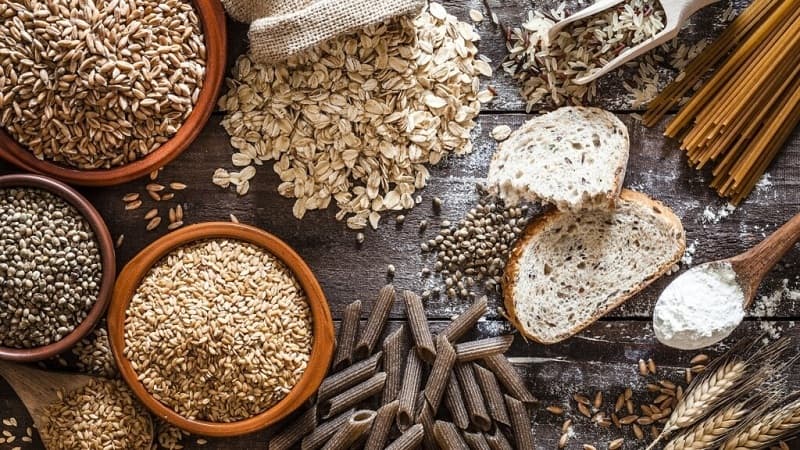
Buckwheat is full of useful minerals and vitamins. It includes:
- B vitamins - maintain the water-salt balance in the body;
- tocopherol - has a beneficial effect on the condition of the skin and hair;
- rutin - takes care of the work of the heart and thyroid gland.
Buckwheat contains phosphorus, calcium, potassium and magnesium. These trace elements have a positive effect on the functioning of the central nervous system, dental health, and normalize blood pressure.
100 g of boiled cereal contains about 110 kcal, BZHU:
- proteins - 12.5 g;
- fats - 3.3 g;
- carbohydrates - 60 g.
Rice improves brain function and energizes the body for the whole day. It includes:
- B vitamins - are responsible for the functioning of the nervous system;
- vitamin E - activates the work of protein in the body;
- vitamin PP - restores lipid metabolism.
There are dozens of varieties and varieties of rice, and each in its own way is useful for the human body. Depending on the variety, the calorie content of dry rice ranges from 300 to 350 kcal, BZHU:
- proteins - 2.2 g;
- fats - 0.5 g;
- carbohydrates - 25 g.
Oatmeal is considered the ideal balanced breakfast. It contains magnesium, iron, calcium, iodine and phosphorus. Vitamins in oatmeal: B vitamins, retinol, tocopherol, nicotinic acid. These vitamins have a positive effect on the appearance of skin, hair and nails.
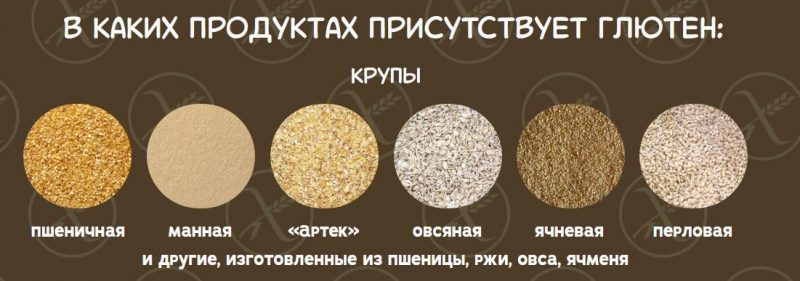
Oatmeal contains about 350 kcal per 100 g. BZHU:
- proteins 17 g;
- fats 7 g;
- carbohydrates 66 g.
Millet removes toxins from the body, cleanses the liver and blood vessels, and has a positive effect on the work of the heart. Copper, potassium, magnesium are contained in this cereal. It contains a lot of dietary fiber, which has a beneficial effect on the functioning of the digestive system.
100 g of millet contain about 350 kcal, BZHU:
- proteins 13 g;
- fats 3.5 g;
- carbohydrates 77 g.
There are many useful substances in oatmeal, buckwheat, rice and millet, so it is better to teach children to eat these cereals from early childhood.
What foods contain gluten
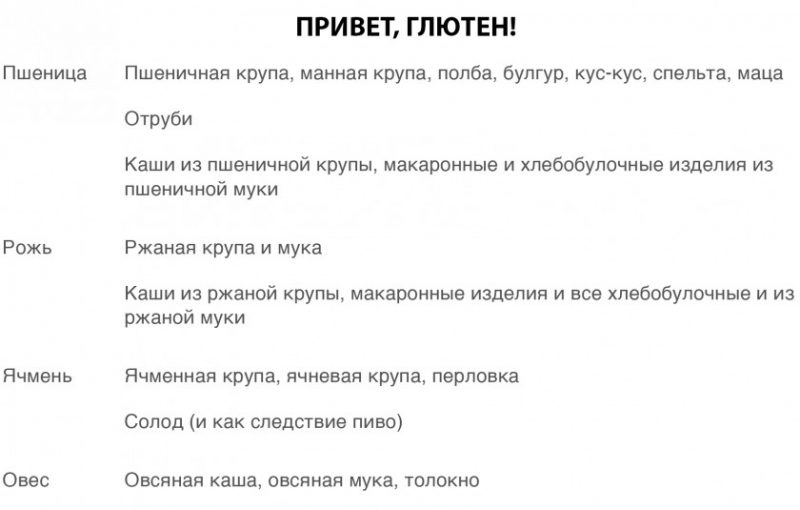
Gluten is a vegetable proteinwhich is composed of glutenin and gliadin. It is found in cereals and has gluten-free properties. Translated from English "glue" - glue.
Rye, wheat and barley more than 70% of this vegetable protein. It raises the dough for baking when preparing pasta, baked goods, breakfast cereals.
Gluten works as a thickener, which is why it is often added to yogurt, sauces, and ketchup.
Products containing gluten:
- bakery products;
- oats, barley;
- canned products;
- sausages;
- sauces and yoghurts;
- ice cream.
Is there gluten in buckwheat, rice, oatmeal and millet?
It is quite easy to check which foods contain this plant protein. When a substance containing gluten comes into contact with iodine, it turns black or dark blue.So at home you can find out where gluten is and where not.
Let's take a closer look at whether buckwheat contains gluten or not. Buckwheat has long been considered one of the healthiest cereals. It contains a huge amount of useful vitamins and minerals. To make it clear whether there is gluten in buckwheat, let's talk about the botanical origin of this cereal.
Buckwheat is a relative of sorrel and rhubarb and has nothing to do with cereals, which means it does not contain gluten. Therefore, gluten-free diets can include it in their diet.
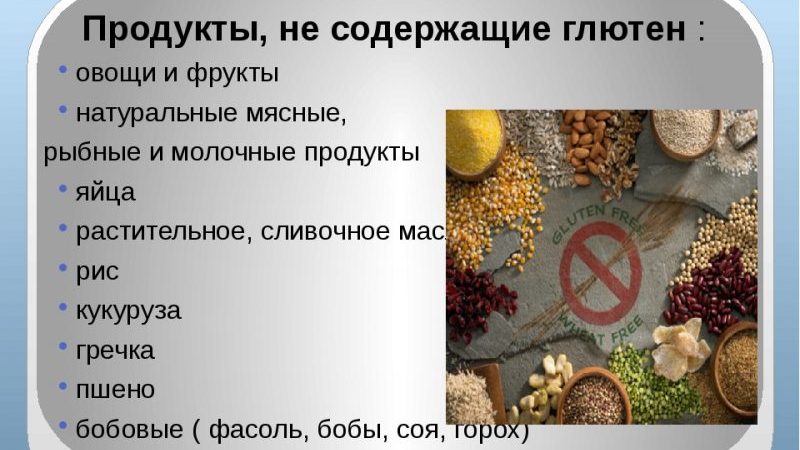
Rice also does not contain this vegetable protein. The most beneficial is brown and wild rice, which are practically not processed.
Millet also does not contain gluten, and porridge made from this grain is a mix of proteins, fiber, vitamins and complex carbohydrates, which give the body a long saturation.
But oatmeal contains gluten.... Is oatmeal gluten harmful? By itself, no. In composition, it differs from the plant protein found in wheat. If you do not have a disease associated with gluten intolerance, include it in your daily diet, it will only benefit the body.
Note. Even people who suffer from gluten intolerance (a disease called celiac disease) can consume oatmeal from time to time. Due to its low gluten content, oatmeal is recognized as a harmless food for people with this disease.
Gluten Free Porridge
If you are following a special diet for health or other reasons, include gluten-free cereals in your diet. Apart from buckwheat, rice and millet, gluten is not found in corn grits, in quinoa and amaranth.
Another way out is cereals intended for baby and diet food. There is no vegetable protein in their composition, the composition of baby cereals meets recognized quality standards.
Council. Study carefully the composition of the products you buy. Unscrupulous manufacturers hide plant proteins by calling them "modified starch" (from wheat) or "hydrolyzed protein".
Is there starch in buckwheat, rice, millet and oatmeal and in what quantity?
Starch is a complex carbohydrate. It is found in almost any vegetable and fruit, but in different quantities. How quickly or slowly starch is absorbed in the human body depends on the degree of its processing.
Important. People suffering from high blood sugar should avoid eating foods that contain starch. It tends to quickly break down and turn into glucose.
Almost all legumes and grains contain starch. During the grinding of wheat into flour, in the manufacture of bakery products, starch passes into a more easily digestible form. Therefore, baked goods or bread that do not even contain sugar can raise blood sugar in a matter of minutes.
Interesting fact... Whole grain bread contains much less "quick starch". It is more difficult for the human body to digest such starch, it takes much more time, and some of it is not absorbed at all. This starch is called resistant starch because it can lower blood sugar levels.
There is starch in buckwheat. 100 g of buckwheat contains about 64 g of starch. Rice grits contain slightly more starch - about 80 g of starch per 100 g of product. Oatmeal and millet contain approximately the same amount of starch - about 60 g.
This carbohydrate is found in many foods that we eat. Eating too much starch can raise blood sugar, which is unhealthy. If foods containing starch are present in your diet in minimal quantities, it will only benefit.
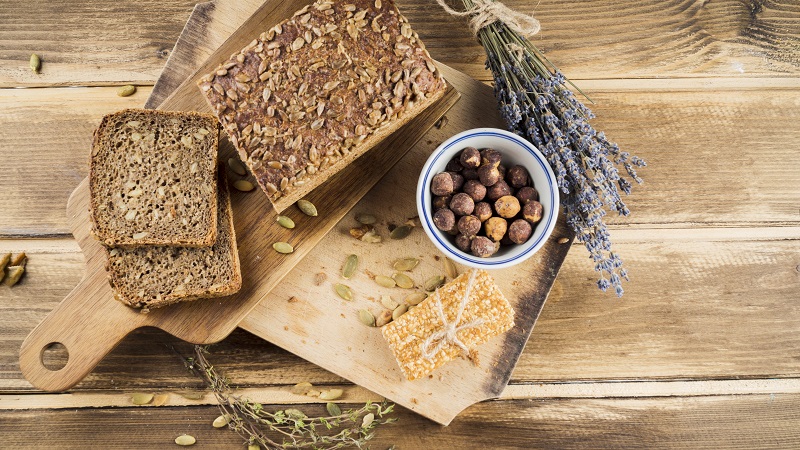
Why is gluten harmful and what is the benefit of it?
About 1% of people around the world have to fight a disease called celiac disease. Celiac disease is gluten intolerance. The essence of the disease: the body fights with the protein, which it perceives as a foreign element.
The main danger is that the immune system fights not only with the protein itself, but also with the tissues that are nearby. Therefore, the stomach, digestive tract, joints and even the brain are affected.
People suffering from celiac disease are forced to follow a gluten-free diet.
A small amount of gluten will not cause any harm to a healthy human body, especially if it is a protein found in oatmeal, and not in fresh baked goods.
Benefits of gluten:
- normalizes hemoglobin levels;
- strengthens bone tissue;
- enhances immunity;
- supports the functioning of the organs of the gastrointestinal tract.
Nutritionists and healthcare professionals still cannot agree on whether plant-based protein is dangerous for healthy people. Some of them believe that many have gluten sensitivity, which people do not even know about until they get tested.
How do you know if you have a gluten intolerance? There are several signs to watch out for:
- abdominal pain;
- vomiting;
- sharp fluctuations in appetite;
- joint pain;
- mood swings.
The main symptom in children is lagging behind the norm in weight and height. Also, vegetable protein in the diet of young children can cause severe allergies.
For complete confidence, it is recommended to undergo an immunological test: to take blood serum for genetic markers for research.
Council. Don't experiment with gluten-free diets yourself. Without enough gluten, the body stops getting the right amount of vitamins B, D, iron and magnesium.
Conclusion
Eating plant-based protein in moderation is unambiguously beneficial, but only if you don't have celiac disease. Do not chase fashion trends in the field of diets, it can harm your health. If you want to change your diet, first get a medical examination and make sure your body is ready for it.